王蔷《英语教学法教程》课后习题详解(听力教学)【圣才出品】
王蔷《英语教学法教程》笔记和课后习题(含考研真题)详解(综合技能)【圣才出品】
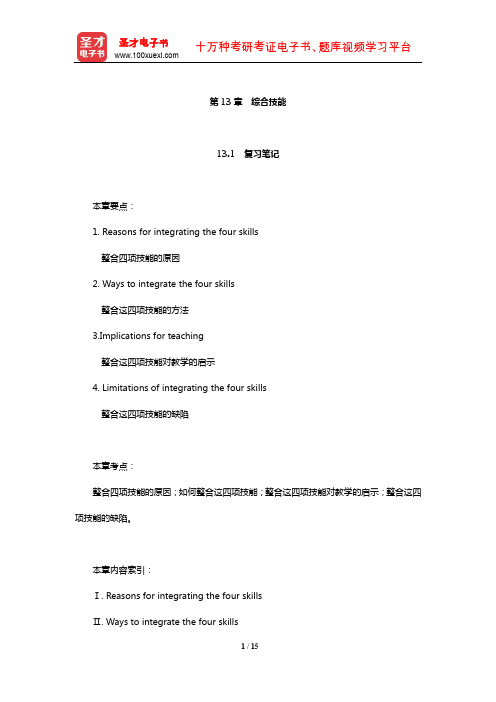
第13章综合技能13.1 复习笔记本章要点:1. Reasons for integrating the four skills整合四项技能的原因2. Ways to integrate the four skills整合这四项技能的方法3.Implications for teaching整合这四项技能对教学的启示4. Limitations of integrating the four skills整合这四项技能的缺陷本章考点:整合四项技能的原因;如何整合这四项技能;整合这四项技能对教学的启示;整合这四项技能的缺陷。
本章内容索引:Ⅰ. Reasons for integrating the four skillsⅡ. Ways to integrate the four skillsⅢ. Implications for teaching1. Focus on discourse2. Adjusting the textbook contents3. Adjusting the timetableⅣ. Limitations of integrating the four skillsⅤ. ConclusionⅠ. Reasons for integrating the four skills|(整合四项技能的原因)【考点:整合四项技能的原因】In our daily lives, we are constantly performing tasks that involve a natural integration of language skills simply because skills are rarely used in isolation. One’s overall competence in a foreign language involves performing effectively a combination of the skills.我们在现实生活中完成的任务需要综合四项技能。
王蔷《英语教学法教程》课后习题详解(交际教学原则与任务型语言教学)【圣才出品】

第2章交际教学原则与任务型语言教学TASK 1Work in groups and brainstorm any differences between language used in real life and language learned in the classroom under the traditional teaching pedagogy. You may reflect on your own learning experiences when you were a middle school student.Key: 1) In real life, language is used to perform certain communicative functions, while in a traditional language classroom, the teaching focus is often on forms rather than functions.2) English teaching tends to focus on one or two language skills and ignore the others. In real life, we use all skills, including receptive skills such as listening and reading, and productive skills such as speaking and writing.3) In reality language is always used in a certain context, but traditional English teaching tends to isolate language from its context.Generally speaking, we often use casual, words in real life, but in classrooms more formal expressions are taught.TASK 2Work in pairs. Think about at least three situations where we are likely to hear the question: “Why don’t you clos e the door?” Discuss how many functions it may have, e. g., a real question, a complaint, or something else. What implications can you draw from this regarding language teaching?Key: Situation 1: One of the speaker’s friends always leaves the door open when he comes into the room. The speaker wants to know the reason so he says this to his friend. (It is a real question.)Situation 2: The husband always leaves the bathroom door open after he uses it. The wife is saying this to her husband. (It is a complaint.)Situation 3: With permission, the student enters the language teacher’s office for conference on writing. Before the talk, the language teacher says this to the student. (It’s a suggestion.)TASK 3Suppose you want to make a suggestion to somebody. How many different ways are there to express this intention? Write down as many ways as you can think of in the box below. Then share what you have written with a partner. Then discuss in what situations you would use each of them?Key: 1. You should buy a black overcoat.2. Have you thought about buying a black overcoat?3. I think you should buy a black overcoat.4. Don’t you think it’s a good idea to buy a black overcoat?5. You’d better buy a black overcoat.6. Why don’t you buy a black overcoat?7. I suggest that you buy a black overcoat.8. If I were you, I would buy a black overcoat.TASK 4Look at the sentences in the box below. They are all in present continuous tense. What is clear is that not all of them describe something that is happening at the moment of speaking. Its meaning depends on the context where it is said. Discuss the possible meaning and function each may have and share your views in a group. What implications can you draw from this for teaching the present continuous tense?Key: The present continuous tense can be used to express something that will happen in a very short time. For example, if you hear ‘Flight CA is now landing’at airport, it means the flight is about to land. So you may start to take out your luggage and prepare to land. Likewise, ‘the train is leaving in ten minutes’doesn’t mean the train is leaving now, but means that the train will leave in ten minutes. Moreover, the present continuous tense may imply a feeling such as complaint, hate or praise, and it also can be used to describe something happening recently. For example, when you hear ‘She is always complaining whenever you talk to her’, you should not think she is complaining or about to complain. On the contrary, she may have just complained and people say this to express disapproval and disdain. Similarly, when you hear ‘He is making progress slowly’, it means that people are praising him because he is progressing every now and then. The present continuous tense here is also used to suggest a process.TASK 5Having considered the components of communicative competence, we now move to discuss its implications for teaching and learning in the language classroom. Work in groups of 4. Discuss the implication of each component of communicative competence to language teaching and learning. Write in the space provided below. Then join another group to share your views.Key:(Adapted from Hedge, 2000:56)TASK 6Use the table below and reflect on your own English learning experiences. What skills have you practicsed most? What skills have been neglected? What are your strong and weak skills? When you are ready, go into groups and pool your。
王蔷《英语教学法教程》课后习题详解(外语课堂管理)【圣才出品】
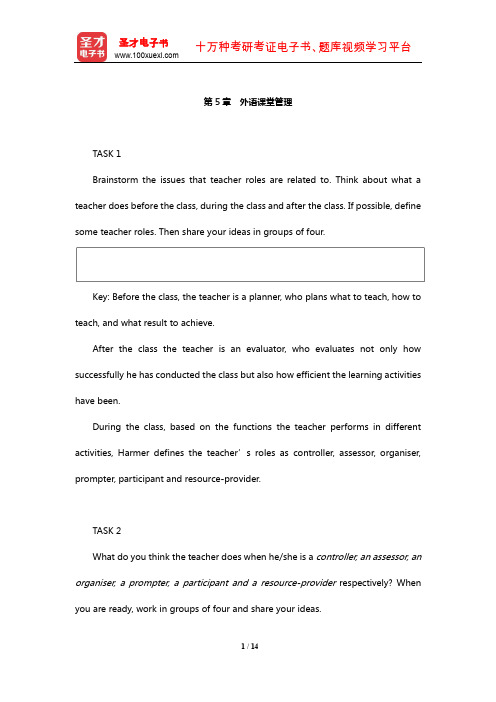
第5章外语课堂管理TASK 1Brainstorm the issues that teacher roles are related to. Think about what a teacher does before the class, during the class and after the class. If possible, define some teacher roles. Then share your ideas in groups of four.Key: Before the class, the teacher is a planner, who plans what to teach, how to teach, and what result to achieve.After the class the teacher is an evaluator, who evaluates not only how successfully he has conducted the class but also how efficient the learning activities have been.During the class, based on the functions the teacher performs in different activities, Harmer defines the teacher’s roles as controller, assessor, organiser, prompter, participant and resource-provider.TASK 2What do you think the teacher does when he/she is a controller, an assessor, an organiser, a prompter, a participant and a resource-provider respectively? When you are ready, work in groups of four and share your ideas.Key: As a controller, the teacher controls the pace so that activities run smoothly and efficiently;As an assessor, the teacher assesses students’performance and give them feedback;As an organiser, the teacher should design and organize meaningful tasks;As a prompter, the teacher should give appropriate prompts.As a participant, the teacher takes part in the activity besides monitoring class.As a resource-provider, the teacher should provide resources for students.TASK 3The following are things that teachers often do in a language classroom. Decide what role the teacher is playing in each activity. Put number 1-6 in the brackets. When you have finished, work in groups and compare your answers.( ) a. The teacher gives students 2 minutes to skim a text, and when time is up, he asks students to stop and answer some questions.( ) b. T: Do you have any hobbies?S: Yes, I like singing and dancing.T: Uhm, and... ?S: I also collect coins.T: Oh, really, how many.., have you already.., collected?( )c.The teacher writes one of five numbers (1-5) on a number of cards (the same number as the students). Each student draws one card. Those who have drawn number 1 will form group 1, and those who have drawn number 2 will form group 2. Thus the students are put into five groups in a random way.( ) d. When a student has made a sentence with borrow, “I borrowed a paper to write a letter”, the teacher says, “Well, we don’t say a pa per, we say a piece of paper.”( ) e. The teacher asks students to take turns to make sentences with a newly learned structure. If someone makes an error, the teacher asks him or her to revise.( ) f. While doing a writing task either individually or in groups, the students need to use a particular word they don’t know. So they ask the teacher.( ) g. The teacher asks a student a question ‘Have you ever bought clothes with problems?’ If the student doesn’t seem to be ready, the teacher says ‘for example, a shirt without...’ and points to the buttons on his own shirt or jacket.( ) h. When the students have in groups decided where to go for an spring outing, the teacher asks each group to tell the others why they have made such a choice.( ) i. When students are doing a group-work task, the teacher joins one or two groups for a short period of time.( ) j. The teacher asks students to produce conversations (either orally or in writing) by using particular patterns or expressions they have just learned.( ) k. The teacher has a word in his mind and asks students to guess by asking only Yes/No questions until they make the correct guess.Key: Numbers 1—6 represent six roles that teachers play.a (1),b (4),c (3),d (2),e (1), f(6), g (4), h (2), i (5), j (1), k (5)TASK 4Brainstorm the advantages and disadvantages of these four types of student grouping. Draw a table like the one below on a piece of paper and note down your ideas. When you are ready, work in groups of four and share your ideas.Key: (The students might come up with other reasonable answers.)According to Harmer (2001:114—118), different interaction patterns have both advantages and disadvantages. They are summarized below.TASK 5The following is a speaking activity. It has a topic and some questions. Think about how you will organize this speaking activity in your class. Write out the steps. Decide whether you are going to use whole class work, pair/group work or individual study. When you finish, compare your steps in pairs.Key: The following steps might apply:1) Whole class work: the teacher goes through the instruction with the students to make sure they know what to do exactly. If possible, give some hint.2) Group work: students work in groups of 4 and discuss what things they should use. Reach an agreement by the end of the discussion.3) Whole class work: group leaders report their discussion result to whole class,justifying their decision if necessary.TASK 6Listed below are some possible characteristics of a disciplined ELT classroom. Do you agree with them? Put a tick or a cross in the appropriate column. Can you add any more? When you finish, go into groups of four and decide on three most important characteristics which are always typical of a disciplined ELT classroom.Key: Most teachers would agree with items 1, 2, 3, 4, 6, 8.Item 1: This does not mean the class is always working together. It means the class is doing what the teacher wants the students to do and learning is taking place according to teachers’ plan.Item 2: The classroom should usually be quiet unless there are discussions or activities. Also, a quiet class means there is a general consensus between students and the teacher.Item 3: Cooperation between the teacher and students is vital in ELT classroom. Otherwise, there will be break-downs in language teaching and learning.。
王蔷《英语教学法教程》课后习题详解(教学评价)【圣才出品】
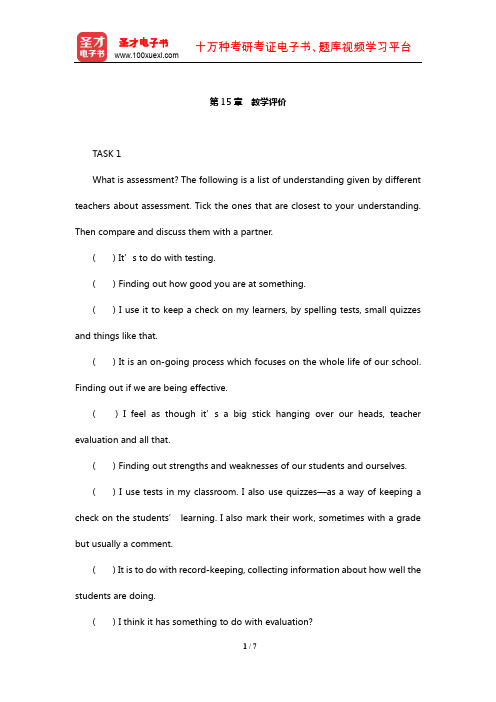
第15章教学评价TASK 1What is assessment? The following is a list of understanding given by different teachers about assessment. Tick the ones that are closest to your understanding. Then compare and discuss them with a partner.( ) It’s to do with testing.( ) Finding out how good you are at something.( ) I use it to keep a check on my learners, by spelling tests, small quizzes and things like that.( ) It is an on-going process which focuses on the whole life of our school. Finding out if we are being effective.( ) I feel as though it’s a big stick hanging over our heads, teacher evaluation and all that.( ) Finding out strengths and weaknesses of our students and ourselves.( ) I use tests in my classroom. I also use quizzes—as a way of keeping a check on the students’ learning. I also mark their work, sometimes with a grade but usually a comment.( ) It is to do with record-keeping, collecting information about how well the students are doing.( ) I think it has something to do with evaluation?(Adapted from Conner, 1991:2) Key: ( ) It’s to do with testing.( ) Finding out how good you are at something.( ) I use it to keep a check on my learners, by spelling tests, small quizzes and things like that.( ) It is an on-going process which focuses on the whole life of our school. Finding out if we are being effective.( ) I feel as though it’s a big stick hanging over our heads, teacher evaluation and all that.( √) Finding out strengths and weaknesses of our students and ourselves.( ) I use tests in my classroom. I also use quizzes—as a way of keeping a check on the students’ learning. I also mark their work, sometimes with a grade but usually a comment.( √) It is to do with record-keeping, collecting information about how well the students are doing.( ) I think it has something to do with evaluation?TASK 2Read the definitions again and draw your own diagram to demonstrate your own understanding of the three terms and their relationships. Does the diagram you created help you, to some degree, understand the relations among the three terms? Explain to each other how testing is related to assessment and assessmentto evaluation.Key:TASK 3What do you think are the purposes of assessment? The chart below has twelve possible purposes of assessment. Do you agree with them? If yes, choose six items that you think are the most important purposes of assessment. Then add one or two assessment purposes that you think apply to ELT classroom.Key:TASK 4According to what you have understood from the above discussions, complete the following table and then discuss it with a partner.Key:TASK 5Work in pairs and answer the following question: Besides testing, what are the other methods that can be used to gather information about the knowledge and performance of language learners? Please give examples if possible. When you are ready, join another pair and compare your ideas.Key: Teacher’s observations, continuous assessment, students’self-assessment, project work, and portfolios.TASK 6Suppose you have been teaching a Senior 1 class for a year. Now you are given the chance to assess the students’ overall language achievement in whatever methods you like. How would you do it? Write out your steps and reasons for doing so.Key:TASK 7What are the possible advantages and disadvantages of different assessments based on different criteria? Discuss the question in groups of 4 and note down your ideas in the chart below.。
王蔷《英语教学法教程》课后习题详解(教材的评价与使用)【圣才出品】

第18章教材的评价与使用TASK 1What do you think are the advantages and disadvantages of using a textbook? Work in groups and make a list in the space provided below. When you are ready, share your opinions with the class.AdvantagesDisadvantagesKey:·The arguments for using a textbook are:·a textbook is a framework which regulates and times the programs;·in the eyes of learners, no textbook means no purpose;·without a textbook, learners think their learning is not taken seriously;·in many situations, a textbook can serve as a syllabus;·a textbook provides ready-made teaching texts and learning tasks;·a textbook is a cheap way of providing learning materials;·a learner without a textbook is out of focus and teacher-dependent, and perhaps most important of all;·for novice teachers a textbook means security, guidance, and support.·The counter-arguments are:·if every group of students has different needs, no one textbook can be aresponse to all differing needs;·topics in a textbook may not be relevant for and interesting to all;·a textbook is confining, i.e., it inhibits teachers’ creativity;·a textbook of necessity sets prearranged sequence and structure that may not be realistic and situation-friendly;·textbooks have their own rationale, and as such they cannot by their nature cater for a variety of levels, every type of learning styles, and every category of learning strategies that often exist in the class, and most important of all, perhaps;·teachers may find themselves as mediators with no free hand and slave, in fact, to others’ judgments about what is good and what is not.(Based on Ur, 1996:184 - 185)TASK 2Think about your English learning experience and make a list of the materials you used. Try to be as specific as possible. Then based on the list, answer these questions: Did you particularly like or dislike any of them? Why? Were the titles on your list widely used then? Are they still being used now? When you are ready, go into groups and pool your lists.Key: Project English, Go For It and so on. They are good textbooks, attracting the students’ curiosity, interest and attention. They are widely used and stillbeing used now.TASK 3Work in groups. Take a textbook that you can find or you are familiar with. Do an on-the-page evaluation, following the procedures of external and internal evaluation introduced above and then decide on the suitability of the textbook for the intended learners. Write an evaluation report about the book. When writing up your evaluation, don’t forget to take into account the features of a good textbook presented above. When you are ready, give a presentation to the whole class.Key: On-the-page evaluation is carried out independent of its users or before it gets into the classroom; there can be two steps.External evaluation involves looking at the claims made by the authors; the intended audience; the proficient level; the context in which the materials are to be used; and how the language has been presented and organized into teachable units/lessons. Then we look through the table of contents and other details in the textbook to see if they reflect what the authors claim. The internal evaluation intends to investigate the suitability.TASK 4Choose a textbook which is used in primary or secondary schools or perhapscolleges in the place where you are studying. Apply Grant’s questionnaires and make detailed evaluation of the textbook. Discuss the two different ways you have experienced in evaluating textbooks and compare the advantages and disadvantages.Key: Grant designed a three-part questionnaire to help teachers examine to what extent a textbook suits the students, the teacher and the syllabus and examination.TASK 5Work in groups of 4 and think of possible reasons for adapting a textbook. Also think about ways of adapting them. After you finish, join the class to make a list.Key: As teachers, we do need good reasons for making adaptations. McDonough and Shaw (2003:77) give the following list of reasons for adaptations.· Not enough grammar coverage in general;· Not enough practice of grammar points that are of particular difficulty to the learners;· The communicative focus means that grammar is presented unsystematically;· Reading passages contain too much unknown vocabulary;·Comprehension questions are too easy, because the answers can be listed directly from the text with no real understanding;· Listening passages are inauthentic, because they sound too much like written material being read out;· Not enough guidance on pronunciation;· Subject matter inappropriate for learners of this age and intellectual level;· Photographs and other illustrative materials not culturally acceptable;· No guidance for teachers on handling group work and role play activities with a large class;· Dialogues too formal and not representative of everyday speech;· Audio materials difficult to use because of problems to do with room size and technical equipment;· Too much or too little variety in the activities;· Vocabulary list and a key to the exercises would be helpful;· Accompanying tests needed.TASK 6Choose a textbook that you are familiar with. Imagine you are going to use the book with a class of students in your locality. Describe your teaching context and your students in order to justify for the adaptations of a unit in the textbook. Makenecessary adaptations and share it with others in the class.Key: A point worth remembering is that adaptation of materials does not necessarily imply that the textbook is defective. Adaptation is needed simply to make the materials more tailored to the needs of the learners or the particular teaching context.。
王蔷《英语教学法教程》笔记和课后习题(含考研真题)详解-第1~3章【圣才出品】
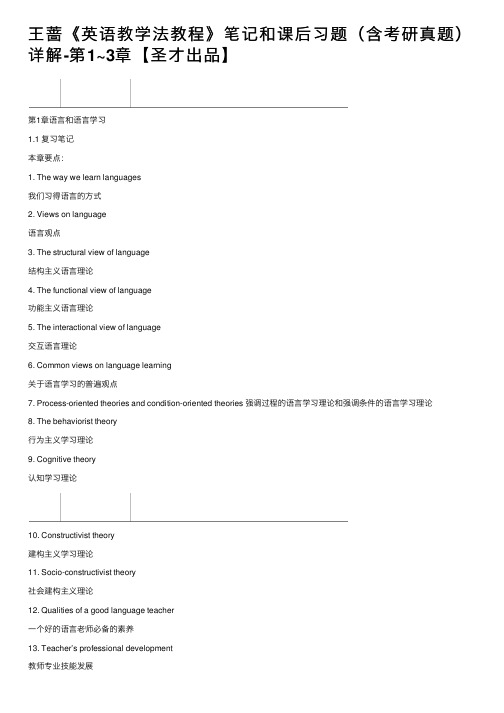
王蔷《英语教学法教程》笔记和课后习题(含考研真题)详解-第1~3章【圣才出品】第1章语⾔和语⾔学习1.1 复习笔记本章要点:1. The way we learn languages我们习得语⾔的⽅式2. Views on language语⾔观点3. The structural view of language结构主义语⾔理论4. The functional view of language功能主义语⾔理论5. The interactional view of language交互语⾔理论6. Common views on language learning关于语⾔学习的普遍观点7. Process-oriented theories and condition-oriented theories 强调过程的语⾔学习理论和强调条件的语⾔学习理论8. The behaviorist theory⾏为主义学习理论9. Cognitive theory认知学习理论10. Constructivist theory建构主义学习理论11. Socio-constructivist theory社会建构主义理论12. Qualities of a good language teacher⼀个好的语⾔⽼师必备的素养13. Teacher’s professional development教师专业技能发展本章考点:我们如何习得语⾔;结构主义语⾔理论;功能主义语⾔理论;交互语⾔理论;关于语⾔学习的普遍观点;强调过程的语⾔学习理论和强调条件的语⾔学习理论;⾏为主义学习理论;认知学习理论;建构主义学习理论;社会建构主义理论;成为⼀个好的语⾔⽼师所要具备的基本素质;教师专业技能发展图。
本章内容索引:Ⅰ. The way we learn languagesⅡ. Views on language1. The structural view of language2. The functional view of language3. The interactional view of languageⅢ. Views on language learning and learning in general1. Research on language learning2. Common views on language learning and learning in general(1)Behaviorist theory(2)Cognitive theory(3)Constructivist theory(4)Socio-constructivist theoryⅣ. Qualities of a good language teacherⅤ. Development of a good language teacherⅥ. An overview of the bookThis chapter serves as an introduction for setting the scene for this methodology course. It discusses issues concerning views on language and language learning or learning in general with the belief that such views will affect teachers’ ways of teaching and thus learners’ ways of learning. The qualities of a good language teacher are also discussed in order to raise the participants’ awareness of what is required for a good English teacher.这⼀章主要是介绍教学法的⽅法论,其中讨论的问题涉及语⾔和语⾔学习的观点,或者⼀般学习及这些观点对教师教学⽅式和学习者学习⽅式的影响,本章也讨论了⼀个好的英语教师应具备的素质,以提⾼语⾔教学参与者对优秀英语教师相关要求的意识。
王蔷《英语教学法教程》笔记和课后习题(含考研真题)详解-第11~13章【圣才出品】
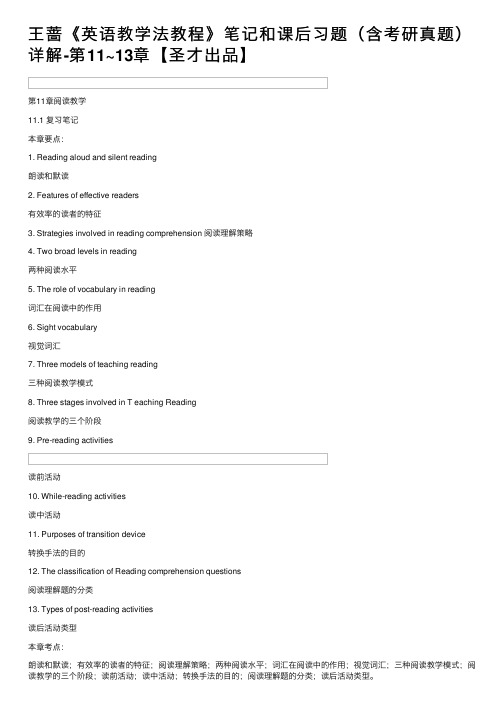
王蔷《英语教学法教程》笔记和课后习题(含考研真题)详解-第11~13章【圣才出品】第11章阅读教学11.1 复习笔记本章要点:1. Reading aloud and silent reading朗读和默读2. Features of effective readers有效率的读者的特征3. Strategies involved in reading comprehension 阅读理解策略4. Two broad levels in reading两种阅读⽔平5. The role of vocabulary in reading词汇在阅读中的作⽤6. Sight vocabulary视觉词汇7. Three models of teaching reading三种阅读教学模式8. Three stages involved in T eaching Reading阅读教学的三个阶段9. Pre-reading activities读前活动10. While-reading activities读中活动11. Purposes of transition device转换⼿法的⽬的12. The classification of Reading comprehension questions阅读理解题的分类13. Types of post-reading activities读后活动类型本章考点:朗读和默读;有效率的读者的特征;阅读理解策略;两种阅读⽔平;词汇在阅读中的作⽤;视觉词汇;三种阅读教学模式;阅读教学的三个阶段;读前活动;读中活动;转换⼿法的⽬的;阅读理解题的分类;读后活动类型。
本章内容索引:Ⅰ. Reflecting on your own reading experiencesⅡ. The way of reading1. Reading aloud and silent reading2. Features of effective readersⅢ. The content of readingⅣ. Strategies involved in reading comprehension1. Definition of reading2. Two broad levels in readingⅤ. The role of vocabulary in reading1. The importance of vocabulary2. Sight vocabularyⅥ. Principles and models for teaching reading1. Three models of teaching reading2. Three stages involved in teaching reading Ⅶ. Pre-reading activities1. Definition of pre-reading activities2. Predicting3. Setting the scene4. Skimming5. Scanning6. Summary on pre-reading activitiesⅧ. Whi le-reading activities1. Information transfer2. Purposes of transition device3. Reading comprehension questions4. Understanding references5. Making inferences6. Summary on while-reading activitiesⅨ. Post-reading activities1. Objectives2. Requirements3. Types of post-reading activitiesⅩ. ConclusionⅠ. Reflecting on your own reading experiences (反思⾃⼰的阅读经验)All of us began reading in our first language at a very early age and we all have experiences of being influenced by certain authors or particular books.我们在很⼩的时候开始⽤母语阅读了,我们都受到某些作者或书籍的影响。
王蔷《英语教学法教程》配套题库【课后练习】(语音教学)【圣才出品】
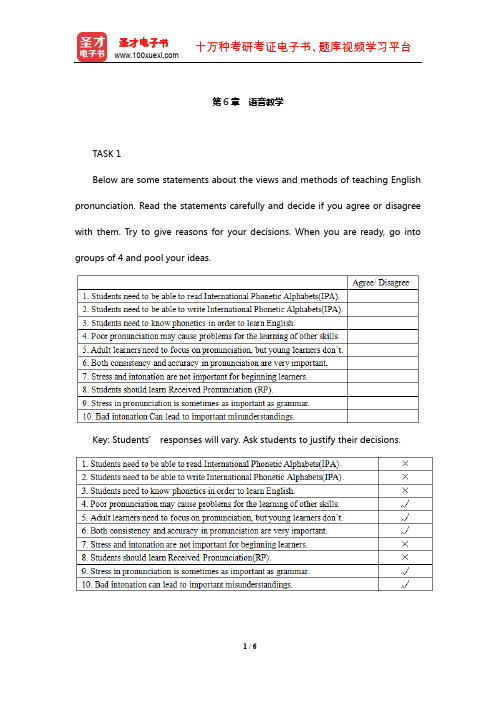
第6章语音教学TASK 1Below are some statements about the views and methods of teaching English pronunciation. Read the statements carefully and decide if you agree or disagree with them. Try to give reasons for your decisions. When you are ready, go into groups of 4 and pool your ideas.Key: Students’ responses will vary. Ask students to justify their decisions.TASK 2Work in groups and brain any reasons why most learners of English as a foreign language cannot acquire native-like English pronunciation. When you are ready, join another group and compare your ideas.Key: First, many learners of English have missed their Critical Period to acquire native-like pronunciation. Second, most learners of English do not have enough exposure. Third, different students have different phonetic abilities due to biological and physiological differences.TASK 3Work in groups and brainstorm the most common problems that Chinese students experience with English pronunciation. Then discuss the possible causes for these problems and possible solutions.Key: One common problem in English learning is neglecting stress and intonation. When teaching pronunciation, we need to put the word in a sentence not just repeat it alone.TASK 4Imagine that you want to focus on a sound which your students are havingdifficulty with. Which of the following steps are necessary? In what order would you teach and practise the sound? On the line tick (√) the steps that you think are necessary. In the brackets, write the order numbers.( ) _____ Get students to repeat the sound in chorus.( ) _____ Explain how to make the sound.( ) _____ Contrast it with other sounds.( ) _____ Write words on the blackboard.( ) _____ Get individual students to repeat the sound.( ) _____ Say the sound in a word.( ) _____ Say the sound alone.( ) _____ Say the sound in meaningful context.Key: (2) √Get students to repeat the sound in chorus.(4) √Explain how to make the sound.(6) √Contrast it with other sounds.(8) ______ Write words on the blackboard.(3) √Get individual students to repeat the sound.(5) √Say the sound in a word.(1) √Say the sound alone.(7) √Say the sound in meaningful context.TASK 5Choose a problematic English sound and design a perception practice activity.When you are ready, go into groups of 5 and try out your activity in turns. Notice how effective your activity proves to be.Key: The teacher reads a series of words which have only one different sound. The students complete the words they hear. Here is an example. The teacher reads gate, late, mate, fate, date, hate, rate, and Kate and the students complete the following:_ate_ate_ate_at_ate_ate_ate_ateTASK 6The following is a word stress exercise taken from Senior English, (2004) Module 4. What would you do to help students practice them?1. Advert/advertisement2. popular/popularity3. celebrate/celebrity4. music/musician5. photograph/photographer6. organize/organization7. publish/publicity8. evacuate/evacuationKey: For this word stress exercise, you may first have students mark out thestress of each word and check in pairs. Then give them a chance to say the words out loud for the whole class to check together. Finally, you will play the recorder for students to listen and repeat after the recorder.TASK 7Look at the following sentences. Their meanings change if the stress is put on a different word. Read each sentence and discuss their meanings.Key:TASK 8Three ways to show the stress pattern Use gestures; Use the voice; Use the blackboard.Work in groups and demonstrate how you can apply the methods introduced above to show the stress pattern of the following words, phrases and sentences.Key: attractive; He was late again. When pronouncing these words and phrases, we can combine gestures and facial expressions, adjust our tone and voice or draw out the pattern of stress.TASK 9Work in groups. Demonstrate how you can indicate the normal intonation in the following sentences. Then change the intonation and see how the meaning can be changed.Key: Free answer. (When it is necessary to mark intonation, we often use rising or falling arrows, such as ↗and ↘. Another way to mark the change of intonation is to draw lines.)。
王蔷《英语教学法教程》笔记和课后习题(含考研真题)详解-第1~3章【圣才出品】
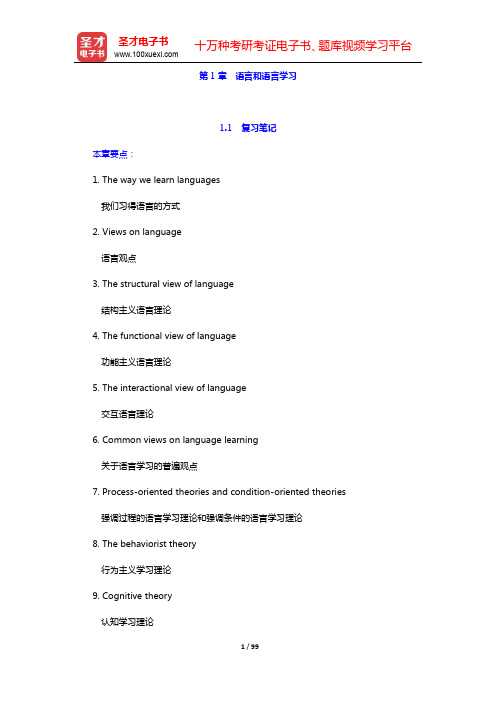
第1章语言和语言学习1.1 复习笔记本章要点:1. The way we learn languages我们习得语言的方式2. Views on language语言观点3. The structural view of language结构主义语言理论4. The functional view of language功能主义语言理论5. The interactional view of language交互语言理论6. Common views on language learning关于语言学习的普遍观点7. Process-oriented theories and condition-oriented theories 强调过程的语言学习理论和强调条件的语言学习理论8. The behaviorist theory行为主义学习理论9. Cognitive theory认知学习理论10. Constructivist theory建构主义学习理论11. Socio-constructivist theory社会建构主义理论12. Qualities of a good language teacher一个好的语言老师必备的素养13. Teacher’s professional development教师专业技能发展本章考点:我们如何习得语言;结构主义语言理论;功能主义语言理论;交互语言理论;关于语言学习的普遍观点;强调过程的语言学习理论和强调条件的语言学习理论;行为主义学习理论;认知学习理论;建构主义学习理论;社会建构主义理论;成为一个好的语言老师所要具备的基本素质;教师专业技能发展图。
本章内容索引:Ⅰ. The way we learn languagesⅡ. Views on language1. The structural view of language2. The functional view of language3. The interactional view of languageⅢ. Views on language learning and learning in general1. Research on language learning2. Common views on language learning and learning in general(1)Behaviorist theory(2)Cognitive theory(3)Constructivist theory(4)Socio-constructivist theoryⅣ. Qualities of a good language teacherⅤ. Development of a good language teacherⅥ. An overview of the bookThis chapter serves as an introduction for setting the scene for this methodology course. It discusses issues concerning views on language and language learning or learning in general with the belief that such views will affect teachers’ ways of teaching and thus learners’ ways of learning. The qualities of a good language teacher are also discussed in order to raise the participants’ awareness of what is required for a good English teacher.这一章主要是介绍教学法的方法论,其中讨论的问题涉及语言和语言学习的观点,或者一般学习及这些观点对教师教学方式和学习者学习方式的影响,本章也讨论了一个好的英语教师应具备的素质,以提高语言教学参与者对优秀英语教师相关要求的意识。
王蔷《英语教学法教程》笔记和课后习题(含考研真题)详解(学习者个体差异与学习策略培养)【圣才】
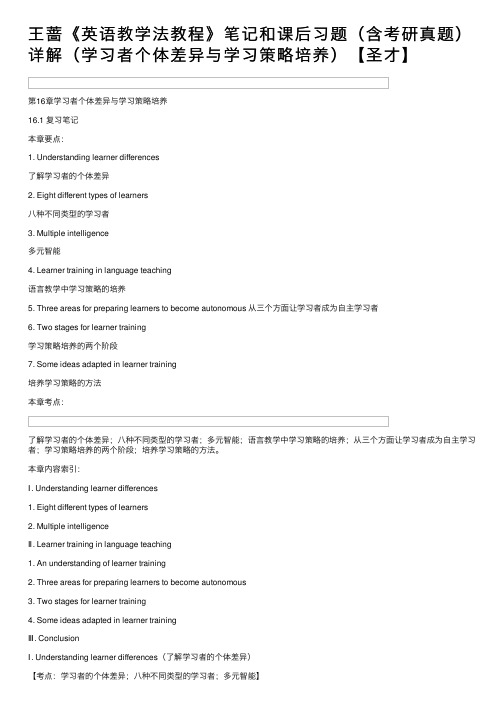
王蔷《英语教学法教程》笔记和课后习题(含考研真题)详解(学习者个体差异与学习策略培养)【圣才】第16章学习者个体差异与学习策略培养16.1 复习笔记本章要点:1. Understanding learner differences了解学习者的个体差异2. Eight different types of learners⼋种不同类型的学习者3. Multiple intelligence多元智能4. Learner training in language teaching语⾔教学中学习策略的培养5. Three areas for preparing learners to become autonomous 从三个⽅⾯让学习者成为⾃主学习者6. Two stages for learner training学习策略培养的两个阶段7. Some ideas adapted in learner training培养学习策略的⽅法本章考点:了解学习者的个体差异;⼋种不同类型的学习者;多元智能;语⾔教学中学习策略的培养;从三个⽅⾯让学习者成为⾃主学习者;学习策略培养的两个阶段;培养学习策略的⽅法。
本章内容索引:Ⅰ. Understanding learner differences1. Eight different types of learners2. Multiple intelligenceⅡ. Learner training in language teaching1. An understanding of learner training2. Three areas for preparing learners to become autonomous3. Two stages for learner training4. Some ideas adapted in learner trainingⅢ. ConclusionⅠ. Understanding learner differences(了解学习者的个体差异)【考点:学习者的个体差异;⼋种不同类型的学习者;多元智能】People learn in different ways. Some people learn better from seeing things and using diagrams while other people enjoy reading and writing more than seeing movies or watching television. Different people have different learning styles.⼈们的学习⽅式不同,⼀些⼈通过观察事物和图表获得更好的学习体验,⽽其他⼈⽐起看电影或电视则更喜欢阅读、写作。
王蔷《英语教学法教程》课后习题详解(国家英语课程标准)【圣才出品】
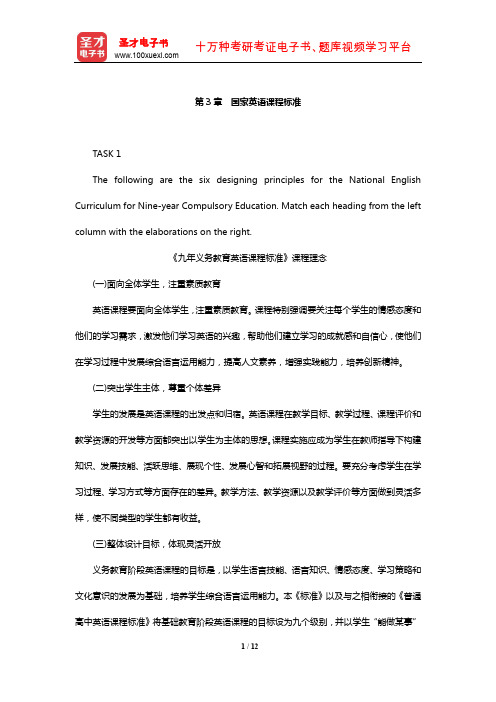
第3章国家英语课程标准TASK 1The following are the six designing principles for the National English Curriculum for Nine-year Compulsory Education. Match each heading from the left column with the elaborations on the right.《九年义务教育英语课程标准》课程理念(一)面向全体学生,注重素质教育英语课程要面向全体学生,注重素质教育。
课程特别强调要关注每个学生的情感态度和他们的学习需求,激发他们学习英语的兴趣,帮助他们建立学习的成就感和自信心,使他们在学习过程中发展综合语言运用能力,提高人文素养,增强实践能力,培养创新精神。
(二)突出学生主体,尊重个体差异学生的发展是英语课程的出发点和归宿。
英语课程在教学目标、教学过程、课程评价和教学资源的开发等方面都突出以学生为主体的思想。
课程实施应成为学生在教师指导下构建知识、发展技能、活跃思维、展现个性、发展心智和拓展视野的过程。
要充分考虑学生在学习过程、学习方式等方面存在的差异。
教学方法、教学资源以及教学评价等方面做到灵活多样,使不同类型的学生都有收益。
(三)整体设计目标,体现灵活开放义务教育阶段英语课程的目标是,以学生语言技能、语言知识、情感态度、学习策略和文化意识的发展为基础,培养学生综合语言运用能力。
本《标准》以及与之相衔接的《普通高中英语课程标准》将基础教育阶段英语课程的目标设为九个级别,并以学生“能做某事”的形式来具体描述各级别的要求。
这种设计旨在体现基础教育阶段学生英语语言能力循序渐进的发展过程,保证英语课程的整体性、灵活性和开放性。
(四)强调学习过程,倡导体验参与现代外语教育理念注重语言学习的过程,提倡采用有利于学生语言能力发展的各种体现学习过程的语言教学途径和方法。
王蔷《英语教学法教程》课后习题详解-第1~9章【圣才出品】
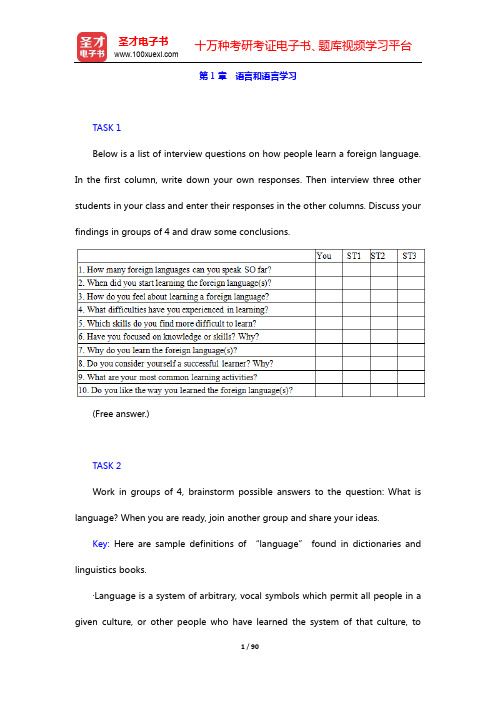
第1章语言和语言学习TASK 1Below is a list of interview questions on how people learn a foreign language. In the first column, write down your own responses. Then interview three other students in your class and enter their responses in the other columns. Discuss your findings in groups of 4 and draw some conclusions.(Free answer.)TASK 2Work in groups of 4, brainstorm possible answers to the question: What is language? When you are ready, join another group and share your ideas.Key: Here are sample definitions of “language”found in dictionaries and linguistics books.·Language is a system of arbitrary, vocal symbols which permit all people in a given culture, or other people who have learned the system of that culture, tocommunicate or to interact. (Finocchiaro, 1964:8)·Language is any set or system of linguistic symbols as used in a more or less uniform fashion by a number of people who are thus enabled to communicate intelligibly with one another. (Random House Dictionary of the English Language 1966:806)·Language is a system of arbitrary vocal symbols used for human communication. (Wardhaugh, 1972:3)·Language is a systematic means of communicating ideas or feelings by the use of conventionalized signs, sounds, gestures, or marks having understood meanings. (Webster’s 3rd New International Dictionary of the English Language 1993:1270) ·Language is a system of communication consisting of a set of small parts and a set of rules which decide the ways in which these parts can be combined to produce messages that have meaning. (Cambridge International Dictionary of English 1995:795)•Language is a system of communication by written or spoken words, which is used by the people of a particular country or area.(Longman Dictionary of Contemporary English)•Language is the system of communication in speech and writing that is used by people of a particular country or area. (Oxford Lear ners’ Dictionary)TASK 31) What are the psycholinguistic and cognitive processes involved in languagelearning?2) What are the conditions that need to be met in order for these learning processes to be activated?Work in groups of 4. Brainstorm the answers to the two questions stated above.When you are ready, join another group and share your ideas.Key: 1) Generally speaking, psycholinguistic and cognitive process involved in language learning are concerned with how the mind organizes new information such as habit formation, induction, making inference, hypothesis, testing and generalization.2) To activate these learning process, physical environment for learning is important, including the number of students, the kind of input learners receive and the atmosphere.TASK 4Work in groups. Reflect on your own learning experiences from early school years to the university. Have you had an excellent English teacher? Try to identify as many qualities as possible of your best English teacher(s). Note down all the qualities that you think are important for a good English teacher.Key: Ethic devotion (responsible, warm-hearted, well-prepared, hard-working, etc.), professional qualities(an excellent command of English, professionally-trained) and personal styles(enthusiastic, humourous, attentive, etc. ) jointly contribute tomaking a good teacher.TASK 5Ethic devotion, professional qualities and personal styles jointly contribute to the making of a good English teacher. All the adjectives in the box below could be used to characterize these three aspects.1. Work in groups of 4 and decide which adjectives describe ethic devotion, which describe personal styles and which describe professional qualities. Please write your answers on a separate piece of paper.2. Add any adjectives to the list which describe further qualities that you feel are missing.3. These adjectives are intended to describe positive qualities or styles. Do you feel that any of them could have a negative side as well? If yes, in what way? For example, an authoritative teacher may make the students feel assured, but may also make the student less free to disagree with him/her.Key: Students’ classification will vary. Please note there is no correct or wrong answer for this task.1.2. The adjectives added are marked in italics in the table above.3. Every coin has two sides. An intuitive teacher may save himself or herselffrom the trouble of referring to books, but it may also give students the wrong impression that they can get right by constant guessing, which is unreliable because intuition is often changeable and unstable. Likewise, a humorous teacher will liven up the atmosphere in class, but students are likely to be distracted by jokes or interesting stories, so much that they care little about learning.TASK 6Work in pairs and discuss how one can become a professionally competent teacher of English. For example, we have to develop our English proficiency first and also we may need to learn from experienced teachers through observations. What else can you think of? Make a list and then pool all your ideas together to find out about your common beliefs.Key: To learn teaching theory; to practice teaching skills; to combine theoreticallearning with teaching practice; to reflect teaching experiences; to learn from one’s own experiences as a learner; to learn from colleagues; to have a needs analysis of students; to solve learning and teaching difficulties through researches; to bear in mind the idea of constant improvement.TASK 7Work in groups. Discuss possible answers to the following questions in relation to the model presented in Figure 1.1.Figure 1.1Key: 1. Stages 1 and 2 are interrelated by a double arrow line because neither of the two stages is really ever terminated. Teachers should always make a point of updating their command of English because language is always changing and they may also forget previous knowledge. This can be done while they are teaching, but very often teachers take time off to have further training in English. This is especially important for teachers who do not have enough exposure to English.2. Practice and reflection are connected by a circle because they are neither independent or separate sub-stages. Teachers do not teach one week and then reflect one week. Rather, they teach and reflect on a daily basis. Besides, practice and reflection complement each other and reciprocate each other. Reflection。
王蔷《英语教学法教程》笔记和课后习题(含考研真题)详解(教学评价)【圣才出品】

第15章教学评价15.1 复习笔记本章要点:1. The differences between testing, assessment and evaluation 测试、评价和评估的区别2. Assessment purposes评价目的3. Methods for assessment评价方法4. The ways to gather students learning information收集学生学习信息的方法5. Different criteria or references of assessment评价的不同标准或参考6. Criteria to assess portfolios评估学生档案的原则7. Assessment principles评价原则8. Drawbacks of using tests for assessment测试评价的缺点9. T est items can be designed in various formats不同形式的测试项目本章考点:测试、评价和评估的区别;评价目的;评价方法;收集学生学习信息的方法;评价的不同标准或参考;如何评估学生档案;评价原则;测试评价的缺点;不同形式的测试项目。
本章内容索引:Ⅰ. Understanding assessmentⅡ. Assessment purposes1. For administrators2. For teachers3. For parents4. For studentsⅢ. Methods for assessment1. Summative assessment2. Formative assessment3. The ways to gather students’learning informationⅣ. Criteria for assessment1. Different criteria or references of assessment2. Criteria to assess portfoliosⅤ. Assessment principlesⅥ. T ests in assessment1. Drawbacks of using tests for assessment2. Test itemsⅦ. ConclusionⅠ. Understanding assessment(理解评价)【考点:测试、评价和评估的区别】The differences between testing, assessment and evaluation:测试、评价和评估的区别:Testing: It often takes the ‘pencil and paper’form and it is usually done at the end of a learning period, such as unit-test, mid-term-test, semester-test etc.测试:通常是“笔纸”形式,通常发生在一个学习阶段末尾,如单元测试、期中测试和期末测试等。
王蔷《英语教学法教程》课后习题详解(语法教学)【圣才出品】
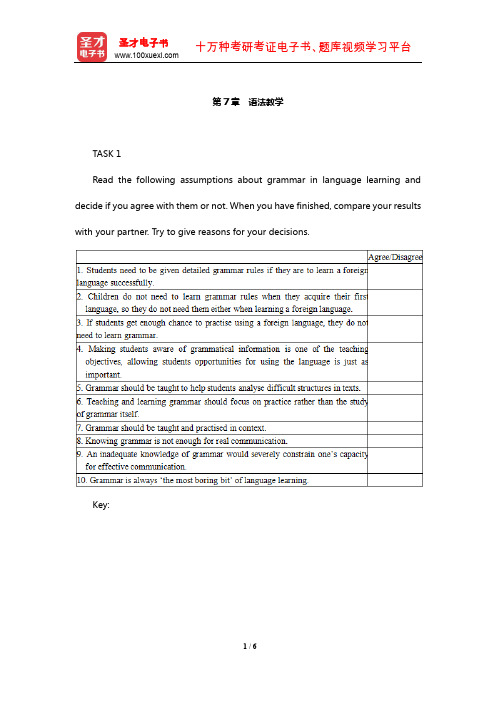
第7章语法教学TASK 1Read the following assumptions about grammar in language learning and decide if you agree with them or not. When you have finished, compare your results with your partner. Try to give reasons for your decisions.Key:TASK 2Reflect on your experiences of learning English in middle school. What method(s) did your teacher use most often to teach grammatical structures? Give examples. How effective was/were the method(s)? When you are ready, share your experiences in groups of 4.Key: The teacher uses the deductive method most often to teach grammatical structures.The deductive method relies on reasoning, analysing and comparing. First, the teacher writes an example on the board or draws attention to an example in the textbook. Then the teacher explains the underlying rules regarding the forms and positions of certain structural words. The explanations are often done in thestudent’s native language and use grammatical terms. Sometimes, comparisons are made between the native language and the target language or between the newly presented structure and previously learned structures. Finally, the students practise applying the rule to produce sentences with given prompts.The deductive method is often criticised.TASK 3Work in groups of 4. Suppose you are going to teach the structure “have/has been doing”. How would you present it? Choose one of the methods to present it. Design a mini lesson plan and demonstrate it to the whole class. Then, discuss the advantages and disadvantages of each method.Key: Step 1: reviewThe teacher guides the students to review the Present Perfect Tense, including definition, main structures, which will be used to explain the new grammar point.Step 2: grammar teaching: Explaining the definition of the Present Perfect Continuous Tense.Teaching method: The guided discovery method. (Understanding the definition of the Present Perfect Continuous Tense is quite difficult for students, the teacher should guide them to learn it and then explain it explicitly to deepen their understanding.Activity: 1.The teacher asks students to translate several groups of sentences and raises questions.1) 我读过这本书。
王蔷《英语教学法教程》课后习题详解-第10~18章【圣才出品】
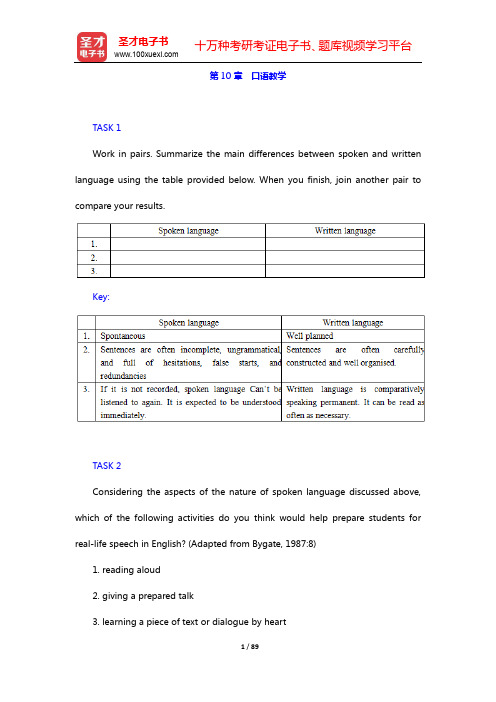
第10章口语教学TASK 1Work in pairs. Summarize the main differences between spoken and written language using the table provided below. When you finish, join another pair to compare your results.Key:TASK 2Considering the aspects of the nature of spoken language discussed above, which of the following activities do you think would help prepare students for real-life speech in English? (Adapted from Bygate, 1987:8)1. reading aloud2. giving a prepared talk3. learning a piece of text or dialogue by heart4. interviewing someone, or being interviewed5. doing a drillKey: 4. interviewing someone, or being interviewedTASK 3Think about a successful speaking activity that you have participated in as a student or led as a teacher. What made it successful? When you are ready, share it with your partner (adapted from Ur, 1996:120).Key: Maximum foreign talk of students, even participation, high motivation and right language level jointly makes a successful speaking activity.TASK 4Work in groups and decide which of the following speaking activities includes an information gap. How can you further adapt the activities to make them more communicative?Activity 1In pairs use the ideas given below to talk about your plans for the future.travel around the world; work hard; be richspeak a second language; be famous; get a good jobhelp people; go to college; buy an expensive car; be happyI am going to learn Spanish.I am going to travel around the world.Activity 2Use the same pictures, but cut them up, paste on cards, and give each student a different picture.Directions: Ask your partner what is in their picture.For example:Student A: What’s in your picture?Student B: There is ____. What’s in your picture?Student A: There is ____.Key: The second task includes an information gap; the further activity: to complete the picture in groups.TASK 5Perform a dialogue with a partner based on cue cards. Speaker A looks at Card A and Speaker B looks at Card B. Then, with your partner make up your own prompts to be used on cue cards. Think about what sort of topics the students would be likely to talk about in their native language.Key: Hi! My name is **. Nice to meet you. Which school do you went to before? Do you live nearby the school? How about going shopping together after school?TASK 6Look at the activity below. Try it out with your classmates. Discuss what level of students you could use this task with. Do you think it would be a successful task? Will all the students participate? Will they enjoy it? Can you think of any potential problems with it? (Adapted from Ur, 1996:124-5)DirectionsDivide the class into groups of 3 or 4 people. Each group has one of the two pictures shown below which everyone in the group can see. Give them two minutes to say as many sentences as they can that describe the picture. Appoint a ‘secretary’ to mark a tick on a piece of paper for each sentence said. Emphasise that the secretary only need to mark a tick; there is no need to write down the sentence. At the end of two minutes, groups report how many ticks they have. Then they repeat the procedure with the second picture, trying to get more ticks than the first time.(Take from Junior English for China (1993), Book 1:69, 75) Key: The task works well with beginning level classes. It is a good task that everyone can participate in but there may be some words they do not know how to say.TASK 7We have discussed a few variations of tasks that can be designed using pictures. Work with a partner, think of a different variation using pictures (or maps or diagrams) that has not been discussed already in this section. Describe what level of students it would be for and what level of communication it would involve.Key: One activity is to cut up a story told by 4-6 pictures and give each member of a group one picture. The task is for the group to reconstruct the story. Another common task can be designed with maps where one speaker tells the other speaker how to get from Point A to a certain destination (without giving away the names of the destinations).TASK 8Work in groups, complete the activity below and then discuss how well it worked.Do you think it would be a successful activity with the students? Do you foresee any problems? Can you think of any ways to improve it so it would be more successful?Directions:You are on a committee that is in charge of deciding what to do with a small amount of money that has been donated to improve your school. You have a list of things to do, but you only have enough money for 5 of the items. You must reach a consensus in your group on which 5 items you will spend the money. Here is the list:·repaint 3 classrooms·paint lines for games on the playground·install lights that automatically turn off to save electricity·buy curtains for 8 classrooms (This will make it easier to see the OHP (Overhead Projector) when the room is darker.)·buy sound absorption panels for 2 classrooms (This will make the classroom quieter so it will be easier to hear each other.)·buy an air conditioner for one classroom·buy 4 new basketball hoops for the playground·buy 15 young trees to be planted for shade around the edges of the playground。
王蔷《英语教学法教程》课后习题详解(英语教育资源的开发与利用)【圣才出品】
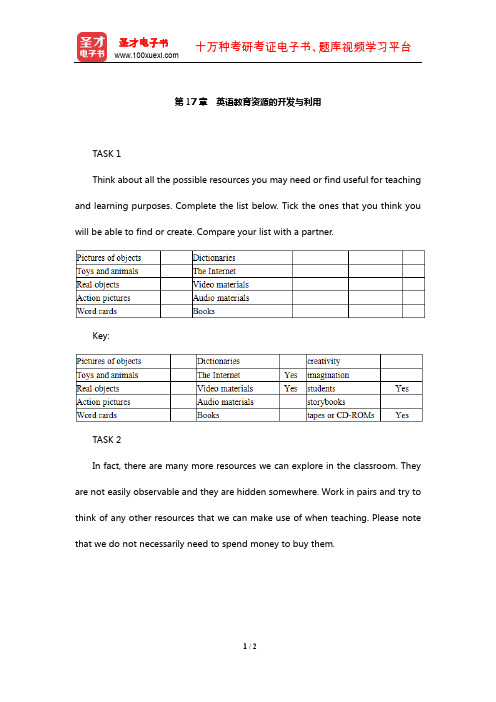
第 17 章 英语教育资源的开发与利用 TASK 1 Think about all the possible resources you may need or find useful for teaching and learning purposes. Complete the list below. Tick the ones that you think you will be able to find or create. Compare your list with a partner.2/2Fra bibliotekKey:
TASK 2 In fact, there are many more resources we can explore in the classroom. They are not easily observable and they are hidden somewhere. Work in pairs and try to think of any other resources that we can make use of when teaching. Please note that we do not necessarily need to spend money to buy them.
1/2
圣才电子书 十万种考研考证电子书、题库视频学习平台
Key: Hidden resources include things like our own gestures, facial expressions, imagination, creativity, our own emotions, our environment, and our knowledge and skills.
王蔷《英语教学法教程》课后习题详解(综合技能)【圣才出品】
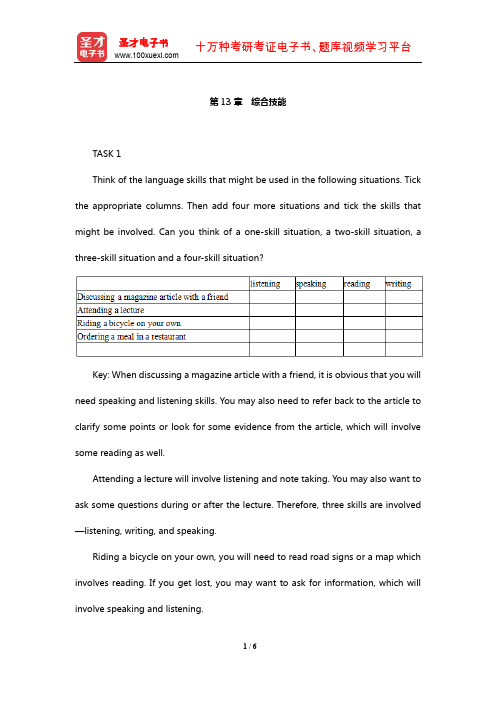
第13章综合技能TASK 1Think of the language skills that might be used in the following situations. Tick the appropriate columns. Then add four more situations and tick the skills that might be involved. Can you think of a one-skill situation, a two-skill situation, a three-skill situation and a four-skill situation?Key: When discussing a magazine article with a friend, it is obvious that you will need speaking and listening skills. You may also need to refer back to the article to clarify some points or look for some evidence from the article, which will involve some reading as well.Attending a lecture will involve listening and note taking. You may also want to ask some questions during or after the lecture. Therefore, three skills are involved —listening, writing, and speaking.Riding a bicycle on your own, you will need to read road signs or a map which involves reading. If you get lost, you may want to ask for information, which will involve speaking and listening.Ordering a meal in a restaurant obviously requires the reading of the menu first. Then ordering food will involve speaking and listening.TASK 2Let us consider a teaching situation in a senior high school. You are to teach a lesson on the theme of advertisement of a product in a newspaper or a magazine. Think about how you can do it. In what ways can you design your activities to integrate some of the skills naturally? Work in pairs and discuss your ideas. Then join another pair to share your ideas.Key: Ask students to read the advertisement; choosing the best advertisement and giving reasons in groups; designing an advertisement of a given product; demonstrating their ads; appreciating classic advertisement.TASK 3Look at the following passage and design:a) a reading comprehension exercise in the form of a dialogue;b) a communicative activity based on the dialogue.Silent WheelsMr. and Mrs. Li’s new car is very special. It does not have a petrol engine. Instead it has an electric engine.“We were worried about pollution,”said Mrs. Li. “Our car is cleaner and quiet er than other cars on the road.”However, their car was not cheap to buy. It cost double the price of a normal family car. There are other problems. Twice a week, the Lis have to recharge the battery, which takes a long time.“Another good thing about electric cars is their working life,”said Mr. Li. “They last much longer than c ars with petrol engines.”The Lis’ car is made of a very light, but strong material called fib er-glass. The car has four doors and can hold five passengers. It can travel at 100 kilometres per hour.“It’s a good car for people who live in Beijing,” said Mrs. Li. “We don’t need to travel long distances.”Key: Groupwork: ask the comprehension questions in the form of a realistic dialogue.Design an interview according to the passage: one student act as the interviewer and the other as Mr. and Mrs. Li. The interviewer asks them questions about their car such as the price, advantages and disadvantages.TASK 4Here’s an out line of a sequence of activities. Working as a group, use the outline as the guide for designing suitable contents for the first two activities. Then share your ideas with other groups.1) Students listen to an interview between a radio reporter and a famous singer.2) Students read a magazine article describing a famous film star.3) Speaking: students make up and act out an interview between the radio reporter and the famous film star.4) Speaking: students interview each other.5) Writing: students write a magazine article about their partner.Key: In activity 1, students can work in groups to write a report of the interview, the group leader should give a report afterwards, which need skills of listening, speaking and writingIn activity 2, students can work in pairs for an interview, one being the reporter and the other the film star.TASK 5Look at the text below. What are the features of its organisation, layout, style and register?33 Whitefield RoadLancasterEngland25th January Dear Liu Ping,Than ks for your letter. It was good to hear from you. I’m glad you are enjoying your new school.We had a very nice Christmas. All my family had Christmas dinner at home. My parents gave me a new dress. I got some lovely presents from my friends as well.I saw on television that Spring Festival is coming soon. What are you going to do then? Please write and tell me.Best wishes,CarmanKey: As a friendly letter, the main text is organized so that it moves from a greeting to the writer’s news, followed by a req uest for information and then closure. The layout has the writer’s address in the top right comer, with the date below; then the letter opens on the left hand side with “Dear...”. The main body of the letter is then organised in paragraphs. At the foot, either on the left or right hand side, there is a valedictory (e.g. Yours sincerely or Best wishes) above the writer’s signature.The style is informal and personal. The informality is shown in the register, the use of short form (Thanks) and contraction (I’m), of Best wishes as valedictory, and of Carman instead of the writer’s full name—there is no printed form of the name under the signature either.TASK 6In groups, discuss the implications of integrating the four skills for your work as teachers. What do you see as the main benefits and the main limitations of this approach? Write your answers in the box.Key: The role of a focus on individual language elements, such as vocabulary and grammar, should not be over- looked, as they can play an important role in helping students to understand the English language system and in enlarging their range of language production. Integration is also demanding of teachers in terms of finding or designing suitable materials, particularly when it is necessary to take into account the differing rates of progress of students in mastering the individual skills.。
王蔷《英语教学法教程》笔记和课后习题(含考研真题)详解(听力教学)【圣才出品】

第9章听力教学9.1 复习笔记本章要点:1. Reasons for poor listening听力不好的原因2. Criteria of judging the list of listening situations判断听力内容的标准3. Characteristics of listening in real life真实生活听力的特点4. Two major purposes in listening听力的两个主要目的5. Principles and models for teaching listening听力教学的原则和模式6. Two approaches used to describe different processes of listening:Bottom-up model;Top-down model两种描述听力理解的方式:自下而上模式和自上而下模式7. Three teaching stages: Pre-listening; While-listening; Post-listening三个听力阶段:听前、听中和听后8. Activities of pre-listening, while-listening and post-listening听前、听中和听后所进行的活动本章考点:听力不好的原因;判断听力内容的标准;真实生活听力的特点;听力的两个主要目的;听力教学的原则和模式;两种描述听力理解的方式:自上而下模式和自下而上模式;三个听力阶段:听前、听中和听后;听前、听中和听后所进行的活动。
本章内容索引:Ⅰ. Reasons for poor listeningⅡ. Listening situations in everyday life1. One reason for students’unsatisfactory listening abilities2. Criteria of judging the list of listening situationsⅢ. Characteristics of the listening processⅣ. Principles and models for teaching listening1. Two major purposes in listening2. Principles of teaching listening3. Two approaches used to describe different processes of listening4. Three teaching stages of listeningⅤ. Pre-listening activitiesⅥ. While-listening activitiesⅦ. Post-listening activitiesⅧ. ConclusionⅠ. Reasons for poor listening (听力不好的原因)【考点:学生听力不好的原因】Understanding learners’listening problems is perhaps the first step for developing effective teaching strategies.为了有效提升听力教学策略,第一步也许是理解学习者在听力方面的问题。
王蔷《英语教学法教程》笔记和课后习题(含考研真题)详解-第4~6章【圣才出品】
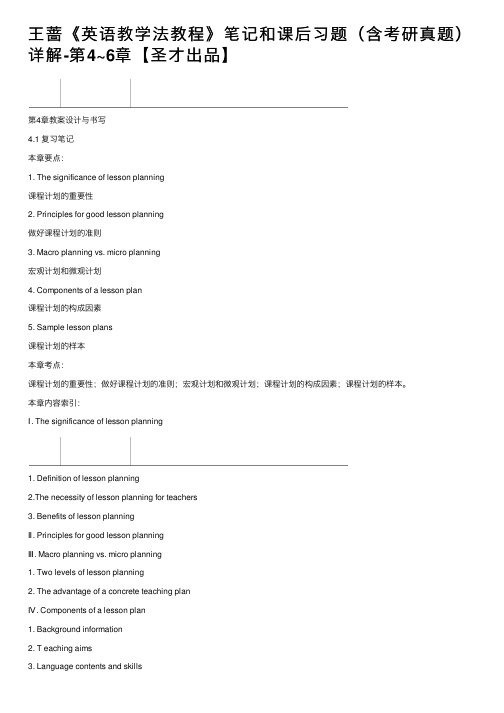
王蔷《英语教学法教程》笔记和课后习题(含考研真题)详解-第4~6章【圣才出品】第4章教案设计与书写4.1 复习笔记本章要点:1. The significance of lesson planning课程计划的重要性2. Principles for good lesson planning做好课程计划的准则3. Macro planning vs. micro planning宏观计划和微观计划4. Components of a lesson plan课程计划的构成因素5. Sample lesson plans课程计划的样本本章考点:课程计划的重要性;做好课程计划的准则;宏观计划和微观计划;课程计划的构成因素;课程计划的样本。
本章内容索引:Ⅰ. The significance of lesson planning1. Definition of lesson planning2.The necessity of lesson planning for teachers3. Benefits of lesson planningⅡ. Principles for good lesson planningⅢ. Macro planning vs. micro planning1. Two levels of lesson planning2. The advantage of a concrete teaching planⅣ. Components of a lesson plan1. Background information2. T eaching aims3. Language contents and skills4. Stages and procedures5. T eaching aids6. End of lesson summary7. Optional activities and assignments8. After lesson reflectionⅤ. Sample lesson plansⅥ. ConclusionⅠ. The significance of lesson planning(课程计划的重要意义)1. Definition of lesson planning课程计划的定义Lesson planning means making decisions in advance about what techniques,activities and materials will be used in the class.课程计划就是提前决定在课堂上使⽤什么技巧、材料、进⾏什么活动。
王蔷《英语教学法教程》配套题库【章节题库】(听力教学)【圣才出品】

第9章听力教学Ⅰ. Fill in the blanks.1. It is important to understand the characteristics or _____ behind the listening situations so that we as teachers can design appropriate activities to help our students to develop effective listening _____ and _____.【答案】processes,habits,strategies/ skills【解析】理解听力情境背后的特征和过程十分重要,如此,教师便可以设计合适的活动来帮助学生形成有效的听力习惯、策略或技能。
2. In most cases, the listening materials are _____ or _____. But in reality we listen to far more things, regardless of which language is used.【答案】daily conversations,stories【解析】在大多数情况下,听力材料为日常对话(daily conversations)或故事(stories)。
但实际上,听力材料所涉及的题材要广泛得多。
3. There are two major purposes in listening. The first is for _____ reasons, like when we have a casual conversation with friends or acquaintances to maintain or build social relationships. The second is to obtain and _____ information.【答案】social,exchange【解析】听力目的主要有两个原因:一个是出于社会原因,如为了保持或建立社会关系与朋友或熟人进行随意的交谈;另一个则是为了获得和交流信息。
- 1、下载文档前请自行甄别文档内容的完整性,平台不提供额外的编辑、内容补充、找答案等附加服务。
- 2、"仅部分预览"的文档,不可在线预览部分如存在完整性等问题,可反馈申请退款(可完整预览的文档不适用该条件!)。
- 3、如文档侵犯您的权益,请联系客服反馈,我们会尽快为您处理(人工客服工作时间:9:00-18:30)。
第9章听力教学TASK 1In your English learning experience, did you find listening more difficult? What are the main difficulties you have encountered? Can you think of any reasons why listening is a difficult skill to develop? Work in groups and pool your ideas.Key: The main difficulties may be quickly forgetting what is heard and unable to recognise words they know. The main reason why listening is so difficult to develop is that listening is often neglected in language teaching due to lack of teaching materials, both with print materials and audio or video tapes, lack of equipment in some schools; and lack of real-life situations where language learners need to understand spoken English.TASK 2How many situations can you think of where you listen to other people in our native language? Work with a partner and think about all the different situations where you need to listen in a routine day.Key: The following list is adapted from Ur, 1996: 105.TASK 3Below is a list of situations where Chinese people may need to listen to English. Choose eight situations that you think are the most frequent. When you are ready, go into groups of 4 and pool what you have chosen.Key:□telephone conversations about business√radio news in English√lessons or lectures given in English√conversations with foreigners□instructions in English√watching television in English√watching movies in English□shop assistants who sell goods to foreigners□deal with tourists□interviews with foreign-enterprises√international trade fairs□socialise with foreigners√negotiations with foreign businesses√Listening to English songs□hotel and restaurant servicesTASK 4Look back at the list of listening situations in Tasks 3. Judge the situations according to the following criteria:·Formal or informal?·Rehearsed or non-rehearsed?·Can the listener interact with the speaker or not?Key:√radio news in English (formal, rehearsed, the listener cannot interact with the speaker)√lessons or lectures given in English (formal, non-rehearsed, the listener can interact with the speaker)√conversations with foreigners (informal, non-rehearsed, the listener can interact with the speaker)√watching television in English (formal or informal, rehearsed or non-rehearsed, the listener cannot interact with the speaker)√watching movies in English (informal, rehearsed, the listener cannot interact with the speaker)√international trade fairs (formal, non-rehearsed, the listener can interact with the speaker)√negotiations with foreign businesses(formal, non-rehearsed, the listener can interact with the speaker)√Listening to English songs (informal, rehearsed, the listener cannot interact with the speaker)TASK 5Suppose you are teaching a low intermediate class of middle school students. You want to give them some listening practice. The following listening materials are available. Which texts would you choose? In what order? Give your reasons.Key: Answers will vary. Since the tasks associated with these listening texts havenot been specified, we can only consider 2 of the 3 categories that Anderson and Lynch mention; the type of language and the context that the listening occurs in. Some of the factors to consider are:1. If other factors are constant, a live speaker is easier to understand than listening to a tape for two reasons: the sound quality of a live speaker is always better no matter how good the recording equipment is; and students have the opportunity to ask a live speaker questions if they don’t understand.2. A videotape is usually easier to follow than an audiotape since there is visual aid; for example, students can see the facial expressions and gestures of the speaker.3. Familiarity of topic: if the topic is familiar to listeners, it will be easier to understand.4. A lack of context makes the task more difficult, therefore, the live talk by a Chinese psychologist would be easier to understand because it would be easier for the students to predict the content of the talk.Perhaps the students can think of more factors. Grading tasks is a very complex decision because there are so many factors involved and it is very difficult to decide which factors are more important in determining the difficulty level of any given listening text and accompanying task.One possible ordering of these four texts in order of difficulty would be:1. A live talk by a competent English-speaking Chinese psychologist about effective study habits (a live speaker is almost always easier to understand due tothe reasons mentioned above);2. A videotape of a talk by a native speaker about the school life of middle school students in the United States (video tape is almost always easier to follow than audiotapes because of the visual aid; the topic should also be fairly familiar to the students because school life of American students isn’t too different from their own school lives);3. An audiotape of an interview with a native English speaker talking about her experiences living in China (topic should be fairly familiar to them because they are familiar with living in China, although hearing about it from a foreigner’s point of view will be different; disadvantage is because this is on audiotape only);4. An audiotape of the news from CRI (China Radio International--91.5 FM) (probably the most difficult to understand because it is on audiotape, and the topic is out of context as it probably isn’t current news).Another factor to consider is the accent of the speaker. How important is it to expose your students to English spoken by native speakers? It is important to be able to understand English spoken by both natives and non-native speakers, of course, but perhaps with beginning students it is more desirable to expose them to as much native English as possible to help them develop good pronunciation habits.TASK 6Look at the two listening activities below and discuss their differences. Which。
